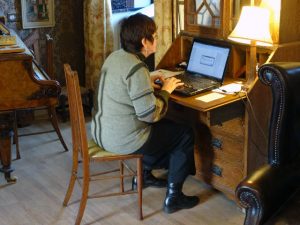For seniors, age-related muscle loss, joint stiffness, and bone weakness all contribute to the tendency to slouch, slump, or hunch over when sitting and standing. If you’re wondering if poor posture in old age is really that big of a deal, the answer is yes.
Poor posture habits can culminate in a host of symptoms including:
- Back and neck pain – wear and tear on the spine from prolonged bad posture coupled with tense and inflamed muscles compensating for the slouching and slumping add up to chronic pain.
- Reduced breathing capacity – hunching your back places added pressure on the thoracic cavity, leaving less room for your lungs to fill with air when you breathe.
- Interrupted digestion – intestinal motility is believed to be at its most efficient digesting food and moving gas when your abdomen is straighter and more upright.
Musculoskeletal damage – poor posture habits can cascade from strain in the back to pelvic imbalance, to even knee and leg issues over time.
So how can seniors make small improvements to their posture to benefit their health? Don’t miss this quick list:
Sit Less, Move More – prolonged sitting which has been linked with early death is also a classic bad posture culprit. Because of mobility issues or illness, seniors may feel prevented from staying active, however, it’s essential to spend less time sitting each day and more time moving, whether it’s walking, exercising, socializing, you name it.
Avoid Text Neck – the more modern posture habit of craning the neck past the shoulders and tilting the head down at a 15 to 45° angle to look at your tech devices places serious strain on your back muscles as they work overtime to hold your head up. Try to:
- Make phone calls or using talk-to-text instead of staring down at your phone and texting
- Use a laptop desk when working on the computer in bed or on the couch
- Hold your smartphone or tablet up in front of your face instead of at your waist
Practice Posture Exercises – your back and core muscles play an important role in properly supporting your spine and helping you maintain good posture. Reinforce these key muscle groups with routine exercise!
Check Your Biomechanics – your feet and the biomechanics of your gait can seriously impact your posture. Overpronating can lead to exaggerated inward knee rotation which stresses the hip and thusly compromises spinal integrity. Check your gait and sitting/standing form with your doctor.


